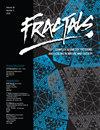PREDICTING THE ELECTRICAL CONDUCTIVITY OF DUAL-POROSITY MEDIA WITH FRACTAL THEORY
IF 2.9
3区 数学
Q1 MATHEMATICS, INTERDISCIPLINARY APPLICATIONS
Fractals-Complex Geometry Patterns and Scaling in Nature and Society
Pub Date : 2023-11-11
DOI:10.1142/s0218348x23501311
引用次数: 0
Abstract
The microspatial structure of porous media affects the electrical properties of reservoir rocks significantly. In this work, a dual-porosity model is established to investigate the electrical properties of porous media, in which tree-like networks and capillary channels represent fractures and pores. By using fractal theory, we established an analytical equation for the conductivity of water-saturated dual-porosity media. The analytical equation, devoid of any empirical constants, expresses the electrical properties of the porous media as a function of some structural parameters ([Formula: see text], [Formula: see text], [Formula: see text], [Formula: see text], [Formula: see text], [Formula: see text], [Formula: see text], [Formula: see text], [Formula: see text], [Formula: see text], [Formula: see text], [Formula: see text]. We also examine the impact of various matrix structural parameters on conductivity. It is found that increasing the length of mother channel ([Formula: see text], length ratio ([Formula: see text], the number of branching layers ([Formula: see text], and tortuosity fractal dimension ([Formula: see text] leads to a decrease in conductivity, whereas increasing the diameter of mother channel ([Formula: see text], diameter ratio ([Formula: see text], the cross-sectional porosity ([Formula: see text], [Formula: see text], and the channel bifurcation number ([Formula: see text] enhances conductivity. Furthermore, we validated this analytical model by comparing it with the experimental data available, and the results demonstrate good agreement. This research has proposed an advanced conductivity model that enables us to better understand the underlying physical mechanisms of the electrical properties in porous media.用分形理论预测双重孔隙介质的电导率
多孔介质的微空间结构对储层岩石的电性影响显著。本文建立了一种以树状网络和毛管通道代表裂缝和孔隙的双重孔隙模型来研究多孔介质的电学性质。利用分形理论,建立了含水饱和双孔隙介质导电性的解析方程。分析方程,没有任何经验常数,表示多孔介质的电特性的一些结构参数([公式:看到文本],[公式:看到文本],[公式:看到文本],[公式:看到文本],[公式:看到文本],[公式:看到文本],[公式:看到文本],[公式:看到文本],[公式:看到文本],[公式:看到文本],[公式:看到文本],[公式:看到文本]。我们还研究了各种基质结构参数对电导率的影响。研究发现,增大母通道长度([公式:见文]、长度比([公式:见文])、分支层数([公式:见文])和弯曲度分形维数([公式:见文])会导致电导率降低,增大母通道直径([公式:见文])、直径比([公式:见文])、截面孔隙度([公式:见文])、沟道分岔数([公式:见文])会导致电导率降低。[原文]增强电导率。通过与现有实验数据的比较,验证了该分析模型的正确性。本研究提出了一种先进的电导率模型,使我们能够更好地理解多孔介质中电性能的潜在物理机制。
本文章由计算机程序翻译,如有差异,请以英文原文为准。
求助全文
约1分钟内获得全文
求助全文
来源期刊
CiteScore
7.40
自引率
23.40%
发文量
319
审稿时长
>12 weeks
期刊介绍:
The investigation of phenomena involving complex geometry, patterns and scaling has gone through a spectacular development and applications in the past decades. For this relatively short time, geometrical and/or temporal scaling have been shown to represent the common aspects of many processes occurring in an unusually diverse range of fields including physics, mathematics, biology, chemistry, economics, engineering and technology, and human behavior. As a rule, the complex nature of a phenomenon is manifested in the underlying intricate geometry which in most of the cases can be described in terms of objects with non-integer (fractal) dimension. In other cases, the distribution of events in time or various other quantities show specific scaling behavior, thus providing a better understanding of the relevant factors determining the given processes.
Using fractal geometry and scaling as a language in the related theoretical, numerical and experimental investigations, it has been possible to get a deeper insight into previously intractable problems. Among many others, a better understanding of growth phenomena, turbulence, iterative functions, colloidal aggregation, biological pattern formation, stock markets and inhomogeneous materials has emerged through the application of such concepts as scale invariance, self-affinity and multifractality.
The main challenge of the journal devoted exclusively to the above kinds of phenomena lies in its interdisciplinary nature; it is our commitment to bring together the most recent developments in these fields so that a fruitful interaction of various approaches and scientific views on complex spatial and temporal behaviors in both nature and society could take place.

 求助内容:
求助内容: 应助结果提醒方式:
应助结果提醒方式:


